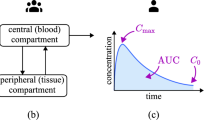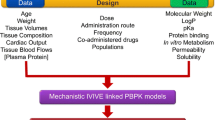Abstract
Determining a drug dosing recommendation with a PKPD model can be a laborious and complex task. Recently, an optimal dosing algorithm (OptiDose) was developed to compute the optimal doses for any pharmacometrics/PKPD model for a given dosing scenario. In the present work, we reformulate the underlying optimal control problem and elaborate how to solve it with standard commands in the software NONMEM. To demonstrate the potential of the OptiDose implementation in NONMEM, four relevant but substantially different optimal dosing tasks are solved. In addition, the impact of different dosing scenarios as well as the choice of the therapeutic goal on the computed optimal doses are discussed.






Similar content being viewed by others
References
Gonzalez D, Rao GG, Bailey SC, Brouwer KLR, Cao Y, Crona DJ, Kashuba ADM, Lee CR, Morbitzer K, Patterson JH, Wiltshire T, Easter J, Savage SW, Powell JR (2017) Precision dosing: public health need, proposed framework, and anticipated impact. Clin Transl Sci 10(6):443–454
Koch G, Datta AN, Jost K, Schulzke SM, van den Anker J, Pfister M (2017) Caffeine citrate dosing adjustments to assure stable caffeine concentrations in preterm neonates. J Pediatr 191:50-56.e1
Hinze M, Pinnau R, Ulbrich M, Ulbrich S (2009) Optimization with PDE constraints. Mathematical modelling: theory and applications. Springer, Dordrecht
Pontryagin LS (1987) Mathematical theory of optimal processes. Classics in Soviet mathematics. CRC Press, Boca Raton
Moore H (2018) How to mathematically optimize drug regimens using optimal control. J Pharmacokinet Pharmacodyn 45:127–137
Kirschner D, Lenhart S, Serbin S (1997) Optimal control of the chemotherapy of HIV. J Math Biol 35(7):775–92
Joshi HR (2002) Optimal control of an HIV immunology model. Opt Control Appl Methods 23(4):199–213
Schättler H, Ledzewicz U (2015) Optimal control for mathematics of cancer therapies. Springer, New York
Ledzewicz U, Maurer H, Schättler H (2019) Optimal combined radio- and anti-angiogenic cancer therapy. J Optim Theory Appl 180(1):321–340
Sharp JA, Browning AP, Mapder T, Burrage K, Simpson MJ (2019) Optimal control of acute myeloid leukaemia. J Theor Biol 470:30–42
Choi W, Shim E (2020) Optimal strategies for social distancing and testing to control COVID-19. J Theor Biol 512:110568
Neilan RLM, Schaefer E, Gaff H, Fister KR, Lenhart S (2010) Modeling optimal intervention strategies for cholera. Bull Math Biol 72(8):2004–2018
Miyaoka TY, Lenhart S, Meyer JFCA (2019) Optimal control of vaccination in a vector-borne reaction-diffusion model applied to zika virus. J Math Biol 79(3):1077–1104
Gontijo AVL, Cavalieri AVG (2021) Optimal control for colistin dosage selection. J Pharmacokinet Pharmacodyn 48(6):803–813
Bachmann F, Koch G, Pfister M, Szinnai G, Schropp J (2021) OptiDose: computing the individualized optimal drug dosing regimen using optimal control. J Optim Theory Appl 189:46-65
Bachmann F, Koch G, Pfister M, Szinnai G, Schropp J (2022) A sensitivity analysis of the optimal drug dosing algorithm OptiDose. Pure Appl. Funct. Anal. 7(4):1127–1140
Beal SL, Sheiner LB, Boeckmann AJ, Bauer RJ (eds) NONMEM 7.5.1 users guides (1989–2022). ICON plc, Gaithersburg. https://nonmem.iconplc.com/nonmem751
Jönsson S, Karlsson MO (2003) A rational approach for selection of optimal covariate-based dosing strategies. Clin Pharmacol Therap 73:7–19
Dayneka NL, Garg V, Jusko WJ (1993) Comparison of four basic models of indirect pharmacodynamic responses. J Pharmacokinet Biopharm 21(4):457–478
Koch G, Schropp J (2018) Delayed indirect response models: realization of oscillating behaviour. J Pharmacokinet Pharmacodyn 45(1):49–58
Schropp J, Khot A, Dhaval SK, Koch G (2019) Target-mediated drug disposition model for bispecific antibodies: properties, approximation, and optimal dosing scenario. CPT Pharmacom Syst Pharmacol 8(3):177–187
Koch G, Wagner T, Plater-Zyberg C, Lahu G, Schropp J (2012) Multi-response model for rheumatic arthritis based on delay differential equations in collagen-induced arthritic mice treated with an anti-GM-CSF antibody. J Pharmacokinet Pharmacodyn 39(1):55–65
Koch G, Krzyzanski W, Perez-Ruixo JJ, Schropp J (2014) Modeling of delays in PKPD: classical approaches and a tutorial for delay differential equations. J Pharmacokinet Pharmacodyn 41(4):291–318
Yan X, Bauer R, Koch G, Schropp J, Perez-Ruixo JJ, Krzyzanski W (2021) Delay differential equations based models in NONMEM. J Pharmacokinet Pharmacodyn 48:763–802
Release MATLAB (2020) The MathWorks. Inc, MathWorks, Natick
van Donge T, Samiee-Zafarghandy S, Pfister M, Koch G, Kalani M, Bordbar A, van den Anker J (2019) Methadone dosing strategies in preterm neonates can be simplified. Br J Clin Pharmacol 85(6):1348–1356
Samiee-Zafarghandy S, van Donge T, Fusch G, Pfister M, Jacob G, Atkinson A, Rieder MJ, Smit C, Van Den Anker J (2022) Novel strategy to personalise use of ibuprofen for closure of patent ductus arteriosus in preterm neonates. Arch Dis Child 107(1):86–91
Author information
Authors and Affiliations
Corresponding author
Additional information
Publisher's Note
Springer Nature remains neutral with regard to jurisdictional claims in published maps and institutional affiliations.
This study was supported by a Grant awarded to GK from the Swiss National Science Foundation; Grant No. 179510. This work has been supported by the DFG, project no. SCHR 692/3-1 (Germany).
Appendices
Appendix 1
Schematic overview on how to implement OptiDose in NONMEM

Appendix 2
Biomarker Indirect Response Model. The data file biomarker.dat for dosing scenario A, B, C with IV bolus administration

Appendix 3
Biomarker Indirect Response Model, dosing scenario A with quadratic or linear reference function. The control file biomarker.ctl

Appendix 4
Biomarker Indirect Response Model. The data file biomarkerinf.dat for dosing scenario A with IV infusion administration

Appendix 5
Biomarker Indirect Response Model, dosing scenario A with IV infusion. The control file biomarkerinf.ctl

Appendix 6
Biomarker Indirect Response Model, dosing scenario B and C. The control file biomarker2.ctl

Appendix 7
Bispecific Antibody Example. The data file antibody.dat

Appendix 8
Bispecific Antibody Example. The control file antibody.ctl

Appendix 9
Target AUC Example. The data file auc.dat

Appendix 10
Target AUC Example. The control file auc.ctl

Appendix 11
Rheumatic Arthritis DDE Example. The data file ra.dat

Appendix 12
Rheumatoid Arthritis DDE Example. The control file ra.ctl

Rights and permissions
Springer Nature or its licensor (e.g. a society or other partner) holds exclusive rights to this article under a publishing agreement with the author(s) or other rightsholder(s); author self-archiving of the accepted manuscript version of this article is solely governed by the terms of such publishing agreement and applicable law.
About this article
Cite this article
Bachmann, F., Koch, G., Bauer, R.J. et al. Computing optimal drug dosing with OptiDose: implementation in NONMEM. J Pharmacokinet Pharmacodyn 50, 173–188 (2023). https://doi.org/10.1007/s10928-022-09840-w
Received:
Accepted:
Published:
Issue Date:
DOI: https://doi.org/10.1007/s10928-022-09840-w




